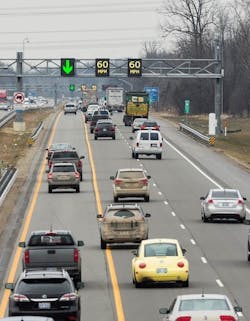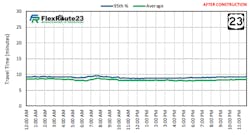Employing solutions to improve travel-time reliability of the road network
By: Jason Firman
Through strong leadership and key champions across the agency, the Michigan DOT (MDOT) has built a foundation and culture that supports not only strategies and solutions to improve safety and mobility, but also operations program funding and project prioritization.
MDOT employs Transportation Systems Management and Operations (TSMO) strategies and solutions to provide more efficient use of existing transportation resources by implementing strategies, deploying technologies, and integrating systems to address freeway and arterial congestion, improve safety and mobility, and encourage sustainability.
To help overcome operations program and project funding challenges, MDOT developed the Trunkline Program Operations Template and provided funding that specifically supports TSMO project strategies and solutions. This template is intended to provide funding for an integrated program to optimize the performance of existing multimodal infrastructure by implementing systems, services, and projects to maximize capacity and/or improve the security, safety, and reliability of the transportation system.
New federal rules require states to measure, monitor, and set goals based upon a composite index of travel-time reliability metrics. Travel-time reliability measures how consistent the travel time is from one point to another, from one day to the next. Federal regulations require states and Metropolitan Planning Organizations (MPOs) to use three performance measures for assessing travel-time reliability. Travel-time data used to calculate each measure is purchased by the Federal Highway Administration (FHWA) and made available for use by states and MPOs. The vehicle probe data set used for the federally required measures is called the National Performance Management Research Data Set (NPMRDS). The data is processed through an analytical software tool known as Regional Integrated Transportation Information System (RITIS). The travel-time reliability measures, as defined in the PM3 federal rule are:
- Level of Travel-Time Reliability (LOTTR) on the interstate: % of person-miles traveled on interstate that are reliable.
- LOTTR on the non-interstate NHS: % of person-miles traveled on the non-interstate NHS that are reliable.
- Freight reliability measure on the interstate: Truck Travel-Time Reliability (TTTR) Index.
Communications, planning, and execution
MDOT established two new funding programs totaling $50 million annually that focus on improving travel reliability, congestion, operations, and safety of traffic on the freeway and non-freeway network. Project selection occurs through the annual Highway Call for Project (CFP) process. A subcommittee of the CFP was established to review and recommend projects and ensure the program/project is meeting goals, strategic direction, and funding targets. The subcommittee, composed of central office and region members, developed criteria for project evaluation. Regions submit candidate projects for consideration annually, as part of the CFP. These programs use a wide range of funding sources: Federal Surface Transportation Program, National Highway Performance Program, Highway Safety Improvement Program (HSIP), Congestion Mitigation and Air Quality (CMAQ), and state “M” funds.
TSMO planning, strategies, and deployment
The information below provides the data-driven analytics used to calculate MDOT Operations Freeway and Non-Freeway program project prioritization. Each element of this scoring system had to be easy to understand, meaningful, and not overly burdensome to produce. Roughly 20 different performance measures were considered, and the process narrowed it down to six to seven different measures. These measures also allow the ability to compare a diverse range of projects to ensure the best projects are selected. Some example type projects include:
- Flex route (Active Traffic Management, hard shoulder running, ramp metering, etc.)
- Weave/merge lanes
- Roundabouts
- Signals improvements (detection, adaptive corridor systems, etc.)
- Turn lanes
- Safety improvements
- ITS devices
- Interchange/intersection improvements
Operations Freeway Scoring (total 100 points):
- (30 points) Benefit/cost ratio
- (30 points) Overall benefit
- (15 points) Safety benefit (time of return)
- (10 points) Combining with an existing project
- (7.5 points) Planning time index > 2 or LOTTR > 1.5
- (7.5 points) Travel time index > 1.5
Operations Non-Freeway Scoring (total 100 points):
- (30 points) Benefit/cost ratio
- (25 points) Overall benefit
- (20 points) Duration since last awarded project in region
- (10 points) Safety benefit (time of return)
- (5 points) Planning time index > 2 or LOTTR > 1.5
- (5 points) Level of service: E or F, or travel time index > 1.5
- (5 points) Combining with an existing project
Outcome, benefit, and takeaways
A key component of these programs was to improve the reliability of the road network and to address the federal reliability requirements. To ensure MDOT is accomplishing this goal, a before-and-after analysis will be performed on all projects. An example analysis was performed on U.S. 23 just north of Ann Arbor where an active traffic management system was recently constructed. This included hard shoulder running, managed lanes, variable advisory speeds, and a queue warning system.
Figures 1 and 2 show the travel time for Southbound U.S. 23 in the AM peak through the project limits. The existing condition was shown to be somewhat congested and quite unreliable. After construction the congestion was all but eliminated and is now considered a reliable segment.
Conclusion
MDOT has secured a dedicated source of TSMO funding to improve corridor safety, congestion, and reliability, separate from traditional reconstruction and rehabilitation funds. These funds work together with ITS, signals, and safety according to the MDOT Trunkline Program Operations Template and align with operational strategic areas of focus in the MDOT Organizational Strategic Plan and the MDOT TSMO Implementation and Strategic Plan. The Freeway and Non-Freeway programs are in the first year of performance and align well with meeting goals of MDOT’s TSMO strategic plan. After the first year of project submittals, very little changes have been requested of the program. The scoring systems have identified the best projects to move forward and as the programs mature, adjustment will be evaluated to ensure they meet the current internal and external customer needs of safety and reliability.
About The Author: Firman is Congestion & Reliability Manager at the Michigan DOT.






